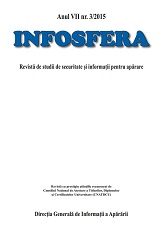Noua frontieră întărită a Europei: linia de demarcaţie din Donbas
The new strengthened border of Europe: Donbas
Author(s): Iulian ChifuSubject(s): Politics / Political Sciences
Published by: INFOSFERA - Revista de studii de securitate si Informații pentru Apărare
Keywords: enforced border; containment; power policies; soft power; interdependency; revisionism; exceptionalism; rules of engagement.
Summary/Abstract: The current situation in Eastern Ukraine describes a reality which could not be predicted some years ago. Some events and development tendencies, such as the adaptive capacity of the EU, the ambitious approach of the liberal security through independency, the annexation of Crimea in March 2014 and the military aggression in the Eastern Ukraine generated a revolution of the geopolitics, which returns to its basic elements. We are coming back to the concept of ”power politics”, which describes a world where rules are imposed by interests of strong geopolitical actors, where international law, security commitments and international responsibilities can be ignored and the military power is back on the table. In this context, we can predict a new type of Cold War, as a border between East and West – a border which is enforced on both sides by military means, but, now, this border is not separating regions following the states frontiers, but it describes, inside a country (Ukraine), a defense line of Ukrainian legitimate authorities, as well as an enforced border between East and West. This line will pass through the Eastern part of Kyiv, but West from the current demarcation line of Donbas region. Formally, everybody will reject it as a border, recognizing Ukraine as a sovereign and independent state, with a reference to Minsk agreements. In fact, this will be a real enforced geopolitical border, with weapons on its both sides, but also with some rules of engagement between East and West, in order to avoid an extended geopolitical war.
Journal: INFOSFERA - Revista de studii de securitate si Informații pentru Apărare
- Issue Year: VII/2015
- Issue No: 3
- Page Range: 30-37
- Page Count: 8

